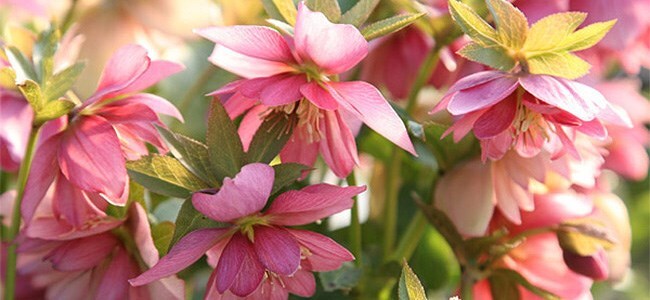|
Once March arrives spring is definitely on the horizon and we the gardeners begins to stir along with the bees and birds. There’s literally a buzz in the air and the earliest bees to arrive are often buff-tailed bumblebee queens (Bombus terrestris) fresh out of hibernation. These large bees need two things urgently in order to survive, sugar-rich nectar for energy and protein-rich pollen for raising the next generation. One of the very best bee survival kits is the hybrid hellebore (Helleborus x hybridus) because the open flowers are easy to access and provide life sustaining nectar and pollen for at least two weeks or more. But the hellebore show doesn’t end there. After the nectar and pollen supplies have disappeared the shell of the flower remains intact providing a presence in the garden for several weeks. This is due to the flowers unusual structure: the petal-shaped sections are leathery sepals rather than soft petals and as a result they shrug off the weather. It’s this long-lasting quality that makes hybrid hellebores so valuable in the spring garden.
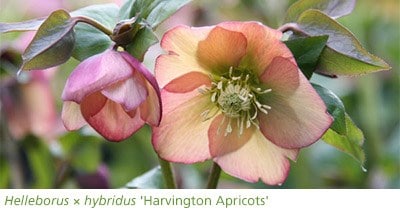
The maintenance regime for hellebores is easy. In early May, remove the flowering stems before they set seed. This will prevent seedlings from replacing your prized plants, although in a wilder garden you may want seedlings to pop up. It’s a personal choice. Whichever, feed your hellebores with a slow-release fertiliser in early May too (such as Vitax Q4), for hellebores are greedy feeders. Other than that, the only maintenance your hellebores need is in early December. Cut away all the leaves so that when the new flowers appear they will be surrounded by young, healthy foliage. This short December haircut will help prevent hellebore blackspot, which can be a problem if the foliage is left on all year. It’s advisable to place hellebore foliage into a green bin, rather than on the compost heap, for this reason. You don’t want to harbour any spores.
If you decide to move one, this can be done either before or after flowering because hellebores are very tolerant and move well as long as you keep the rootball intact. If you need to divide, make sure that the plant is cut into large chunks, because individual noses (growing points) normally don’t survive. Split it into two or three only, for if you try to divide finely you will weaken your plant. This fate befell Helen Ballard’s famous hybrids. She could never raise enough to meet demand and her stock plants often faded through over division.
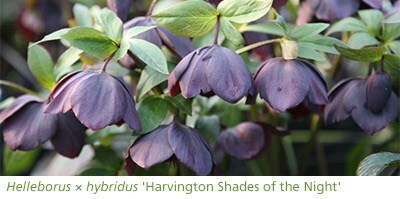
The difficulty over dividing hellebores has meant that modern breeders have concentrated on raising new hellebores from seed rather than division. This takes at least four years and as a result hellebores cost more than many plants. However they are worth it for they live far longer than most other plants and can survive for decades. The hybrids, which often involve several wild species, add to the genetic melting pot producing many colours from apple-green to soot-black. Flower shape varies too, from round single to ragged double and there are often spots and streaks to lure in the bees. Everyone has their own preference.
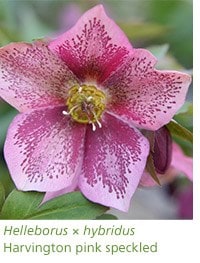 This inherent genetic variety led Hugh Nunn to select for colour and shape when developing his Harvington seed strains, a process that took many years. He selected the best colours and then the most healthy, to produce seed-raised hellebores of great quality. The beauty of these so-called Harvington hybrids is that the plants are grown to the correct size and sold in the first year they flower, having been raised outside. They are not pot bound, or hot house beauties. They soon get established in the garden. However if the roots are going round the pot, distress them with your fingers or cut them with secateurs so that they can plunge into the ground. This inherent genetic variety led Hugh Nunn to select for colour and shape when developing his Harvington seed strains, a process that took many years. He selected the best colours and then the most healthy, to produce seed-raised hellebores of great quality. The beauty of these so-called Harvington hybrids is that the plants are grown to the correct size and sold in the first year they flower, having been raised outside. They are not pot bound, or hot house beauties. They soon get established in the garden. However if the roots are going round the pot, distress them with your fingers or cut them with secateurs so that they can plunge into the ground.
Singles are the most bee-friendly and among the Harvington seed strains are the Harvington pink speckleds. Their colour is strong enough to stand out in the garden and will make a perfect partner for spring blossom. You might try an overhead canopy of Prunus × incam ‘Okamé’, an award-winning bushy cherry with carmine-pink blossom. There is also a Harvington double pink and it’s possible to blend these together with the pink speckleds in the same group. Other pinks have picotee edges, a dark fine margin to the petals, and these help to define and refine the flowers in the garden setting.
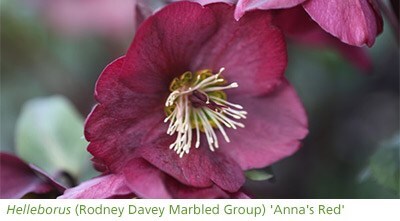
The richest hellebores are bright red, a sought-after colour in short supply. Harvington have bred a double red and a single red and these glow in spring sunshine so place these where they catch some spring sunshine. The most sumptuous red of all is ‘Anna’s Red’, bred by plantsman Rodney Davey of RD Plants. He named his complicated cross after Anna Pavord the garden writer. The huge flowers, which are held on sturdy stems, are a clear ruby-red and the handsome marbled foliage hovers between silver, holly-green and pink.
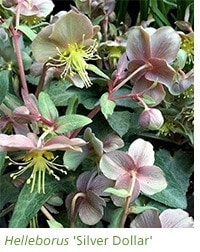 Hellebores with marbled foliage should have their leaves left intact over winter, to flatter the flowers. They are generally sterile hybrids, so set no seeds, and they tend to need reasonable drainage, so place them at the front of a woodland border. Helleborus × sternii has slightly frosted green foliage and pink-flushed flowers on a compact plant, so it’s best to group three or five together in a border, or use one in a mixed winter container. Splashes of sugar-pink also work well at this time of year and Helleborus x ericsmithii 'Pirouette' (PBR) is another sterile hybrid with a much longer flowering time. The dark-green foliage sets off the pink flowers, so this hellebore stands out well in the garden, or in a container. Hellebores with marbled foliage should have their leaves left intact over winter, to flatter the flowers. They are generally sterile hybrids, so set no seeds, and they tend to need reasonable drainage, so place them at the front of a woodland border. Helleborus × sternii has slightly frosted green foliage and pink-flushed flowers on a compact plant, so it’s best to group three or five together in a border, or use one in a mixed winter container. Splashes of sugar-pink also work well at this time of year and Helleborus x ericsmithii 'Pirouette' (PBR) is another sterile hybrid with a much longer flowering time. The dark-green foliage sets off the pink flowers, so this hellebore stands out well in the garden, or in a container.
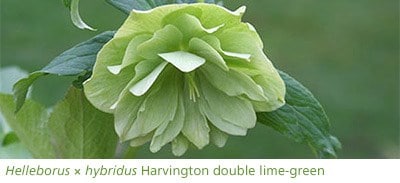
If you have a largish woodland garden the Corsican species (Helleborus argutifolius) will provide you with toothed, shiny green leaves framing lime-green flowers. Its habit of laying its stems down, like the spokes of a large wagon wheel, needs a sympathetic approach and it’s not for the smaller garden. However the lime-green flowers can look very spring-fresh with miniature blue bulbs such as scillas. There is a single Harvington lime, which will provide a foil for brighter colours, or if you prefer it, Harvington double lime-green.
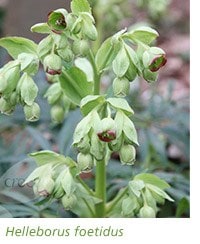 One of our British native hellebores, H.foetidus, thrives in deep shade. The cluster of small green bells, each one ringed in maroon, gives this dainty woodlander a shy grace and the dark-fingered foliage has a black sheen. Don’t let the common name of stinking hellebore put you off. The slightly meaty smell is designed to attract flies, their main pollinator. This species will also set seed and it’s an upright foot-high plant, so generally not a nuisance. It’s one parent of Helleborus × sahinii ‘Winterbells’, a long-flowering sterile hellebore that also involves the Christmas rose H. niger. ‘Winterbells’ flowers early due to the Christmas rose influence, but it is much more floriferous with lots of smaller pink-flushed green flowers. It would make a great winter container, mass-planted together with the ivory-white flowers and rich evergreen foliage of Sarcococca confusa. Stylish fragrance, from the sarcococca, and cool elegance from the green-tinted hellebores will give months of pleasure in winter. One of our British native hellebores, H.foetidus, thrives in deep shade. The cluster of small green bells, each one ringed in maroon, gives this dainty woodlander a shy grace and the dark-fingered foliage has a black sheen. Don’t let the common name of stinking hellebore put you off. The slightly meaty smell is designed to attract flies, their main pollinator. This species will also set seed and it’s an upright foot-high plant, so generally not a nuisance. It’s one parent of Helleborus × sahinii ‘Winterbells’, a long-flowering sterile hellebore that also involves the Christmas rose H. niger. ‘Winterbells’ flowers early due to the Christmas rose influence, but it is much more floriferous with lots of smaller pink-flushed green flowers. It would make a great winter container, mass-planted together with the ivory-white flowers and rich evergreen foliage of Sarcococca confusa. Stylish fragrance, from the sarcococca, and cool elegance from the green-tinted hellebores will give months of pleasure in winter.
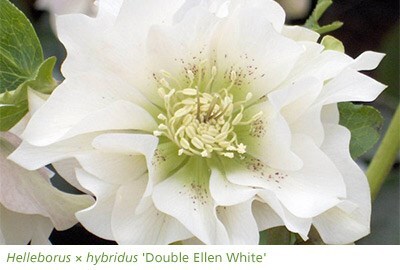
White hellebores have an understated elegance and they stand out well in the spring garden, without looking brash, because the light is still soft enough to flatter in spring. White will light up the shadiest areas, perhaps with the viridiflora tulip ‘Spring Green’, or add evergreen ferns such as the mossy-fronded Polystichum setiferum Plumosomultilobum Group. This fern, with the very long name, keeps a green presence in most winters and it will help frame your white hellebores, although like most ferns it must have summer shade to thrive. Double white hellebores include the lightly freckled 'Double Ellen White’, the pink and green flushed single 'Pretty Ellen White’ and the single ‘Harvington white’.
Seductive, black-toned hellebores tempt us all but need very careful placing. Seen against bare earth their colours float into the background all too easily, so put them in front of evergreens, or by a white-stemmed birch (such as Betula utilis var. jacquemontii), or use a ghost bramble (Rubus cockburnianus) if you’re brave enough to weather the prickles. Harvington Smokey Blues, a purple-black single, or the equally dark 'Double Ellen Purple’, or ‘Harvington Shades of the Night’ will all add a sultry presence.
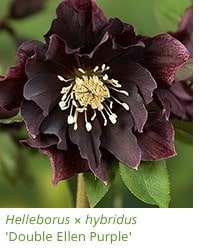 There are also yellows, but again place them carefully because yellow hybrids tend to flower precociously early and can be caught and blackened by frost. Find a sheltered place in some shade, to lessen cold weather damage, and they will glow as effectively as moonbeams. Some are speckled such as Harvington yellow speckled. Finally snap up an apricot hellebore, because these are subtle affairs with softly warm-toned flowers often held on dark stems. They glow in shade. You can’t have too many hellebores and they can be used to form the backbone of a woodland garden, drifting through spring bulbs, or you can pot them, or use them in a strategic position. They’ll not only look lovely, the bees will adore you and your garden. There are also yellows, but again place them carefully because yellow hybrids tend to flower precociously early and can be caught and blackened by frost. Find a sheltered place in some shade, to lessen cold weather damage, and they will glow as effectively as moonbeams. Some are speckled such as Harvington yellow speckled. Finally snap up an apricot hellebore, because these are subtle affairs with softly warm-toned flowers often held on dark stems. They glow in shade. You can’t have too many hellebores and they can be used to form the backbone of a woodland garden, drifting through spring bulbs, or you can pot them, or use them in a strategic position. They’ll not only look lovely, the bees will adore you and your garden.
|



